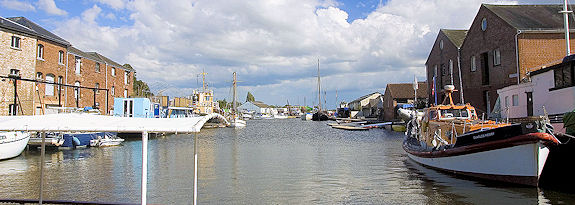
Opened 1566 and later extended. The first canal to be built in Britain since Roman times and the first to use Pound Locks.
Exeter Quay, Haven Road, Exeter EX2 8BP
The River Exe is a tidal river, once navigable up to the centre of Exeter, creating a thriving inland port. In the late 13th century a weir was built across the river to power mills belonging to Isabella de Fortibus, the Countess of Devon, severing Exter's link with the sea. It was restored in 1290, then again blocked by a new weir built in 1317 by Hugh de Courtenay, 9th Earl of Devon. De Courtenay also built a quay at Topsham, thus requiring boats to unload and pay tolls before reaching Exeter.
After 250 years of petitioning to have the waterway re-instated, Edward VI finally granted permission in 1550, but the river channel had by then silted up. In 1563, Exeter traders employed John Trew of Glamorgan to build a canal to bypass the weirs and rejoin the River Exe in the centre of the city where a quay would be built.
Work began in February 1564, and was completed in late 1566 or early 1567. The canal utilised three vertically gated locks - the first pound locks to be built in Britain - which could accommodate boats up to 16 tonnes. The original cut was 0.9 m (3 ft) deep and 4.9 m (16 ft) wide. It ran for 2.8 km (1.75 miles) from immediately below the Countess Weir to the centre of Exeter; unfortunately, the navigation could not be entered at all tidal states, making the double transfer of cargo over such a short distance uncompetitive compared with road transport. The weir that maintains the water level in the quay is named "Trew's Weir" after the canal's builder.
In 1677 the canal was extended and the entrance was moved downstream to Topsham. In 1701 the canal was deepened and widened to allow the passage of ocean-going ships and the number of locks reduced to one. With the addition of floodgates fitted to the canal entrance, the canal found new success until the decline of the wool trade and the emergence of the railways.
Attempts to connect Exeter and the South West to the national canal and rail networks were signally unsuccessful. The Grand Western Canal linking Exeter to Bristol (1796) was never completed; The Bristol & Exeter Railway link to the canal basin was postponed in 1832 and 1844; The South Devon Railway ran services to the canal from 1867, but by this time the canal was too small to attract the now much larger ocean-going vessels and the canal was taken over by its creditors for sixteen years. Use of the canal has declined gradually ever since.
The canal has not been in commercial use since 1972, but has seen increasing leisure use and the redevelopment of the city basin. A small hand-powered passenger ferry operates across the canal - a ferry has been continuously operational since at least 1641.
The Red Wheel Heritage Plaque was erected in September 2020 during the Covid 19 pandemic. The plaque was formally unveiled on 27th September 2021 by Lord Mayor of Exeter, Councillor Trish Oliver assisted by Lady Judy McAlpine, NTT President; Stuart Wilkinson, NTT Chairman and Chris Heaps, NTT Trustee
By road: From the High Street, turn left and head down South Street. At The bottom of the hill, turn right just before the White Hart pub and go through the subway, which runs under Western Way. On the other side of Western Way, walk down Quay Hill onto the historic quayside where the Ship Canal is located.
By rail: Exeter St Thomas Station is approx 3.5 km away

Blair, John, Waterways and Canal-Building in Medieval England, Oxford University Press, ISBN-10: 0199217157 (2007)
Burton, Anthony, The Canal Builders, The History Press, ISBN-10: 0752435450 (2005)
Clew, Kenneth R., The Exeter Canal, Phillimore & Co, ISBN-10: 0850335442 (1984)
Greene, Julie, The Canal Builders: Making America's Empire at the Panama Canal, Penguin Books, ISBN-10: 0143116789 (2010)
Harris, Helen, Grand Western Canal (Inland Waterways Histories), David & Charles, ISBN-10: 0715362542 (1973)
Jackman, William, The Development of Transportation in Modern England, Volume I, BiblioBazaar, ISBN-10: 1115685813 (2009)
Miller, F. P., Vandome, A. F. & McBrewster, J., Chard Branch Line: Somerset, Chard, Somerset, Branch line, Southern Railway routes west of Salisbury, Bristol and Exeter Railway, Taunton Railway, Alphascript Publishing, ISBN-10: 6130272405 (2009)
Sharman, M., Broad Gauge of the Great Western Railway, the Bristol and Exeter Railway and the North and South Devon Railways, The Oakwood Press, ISBN-10: 0853613141 (1985)
Wood, Cyril J., The Manchester Ship Canal: The Big Ditch, The History Press, ISBN-10: 075242811X (2005)
Devon Walks - Circular Walk around the Exeter Ship Canal
Exeter City Council - Exeter Woollen trail
The Turf Hotel - At the Gatewayto the Exeter Ship Canal